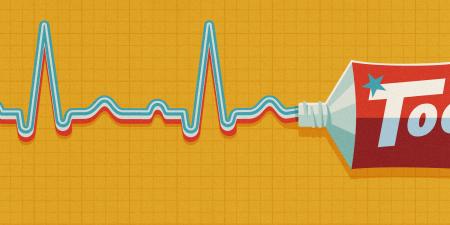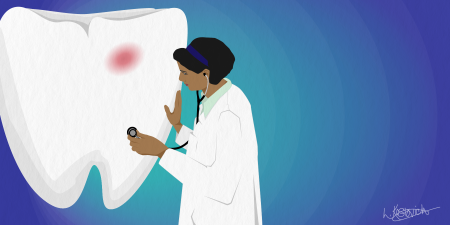Abstract
Arbitrarily cordoning off the mouth from the rest of the body is the educational approach that, since 1840, has been responsible for the medical-dental schism that persists today, preventing oral health’s integration with overall health. This divide has also thwarted oral disease prevention initiatives, access to services, and health equity. This article offers an educational plan for reunifying medicine and dentistry, which involves interprofessional education, dual degree training, integrating oral health into medical education, and integrated residency training.
Rebuff and Persistent Schism
Long referred to by dentists as the “historic rebuff,”1 the divide between medicine and dentistry began in 1840 when physicians at the University of Maryland College of Medicine rejected a proposal from colleagues to include dental instruction in the medical curriculum, resulting in the formation of the school’s separate College of Dentistry.2 Dentistry’s rejection of Medicare in the 1960s2 exacerbated the longstanding schism and created the current imbalance in reimbursement structures for medical and dental care.3,4,5,6 (Interventions deemed “dental” for patients with serious and complex oral, facial, and cranial conditions, for example, still incur tremendous financial burden on patients and families.) The depth of the division between medicine and dentistry is discernible even within a single organization in the separation of patients’ medical and dental electronic health records, although integration would help coordinate comprehensive care, reduce inefficiency, enable and ease referrals, and facilitate access to diagnostic and treatment services.
Dentistry as Medicine
The separation of professional education, reimbursement structures, and records management has underscored the arbitrary separation of mouth from body, preventing oral health integration into general medical care and obstructing oral disease prevention initiatives, access to care, and equity.2,7 Some leaders in health care continue to call for medical-dental integration. The Mayo Clinic, for example, maintains an oral surgery service it included over a century ago.8 Charles H. Mayo, MD, addressed the American Dental Association in 1928, stating: “The practice of medicine includes dentistry and dentistry is the practice of a special branch of medicine.”9 In 1962, Surgeon General Luther Terry, MD, DSc, stated: “Health is indivisible,”10 foreshadowing the first Surgeon General’s report on oral health in 2000.11
Dentistry is already included in medicine in some places in Canada and the United States. The Mayo Clinic, for example, promotes medically supportive oral health collaborations between dentists and physicians, with interprofessional teams treating head and neck cancers, craniofacial syndromes and growth dysplasias, temporomandibular disorders, and obstructive sleep apnea and ensuring that cardiovascular and transplant patients are free of oral disease prior to surgery. Yet, despite enhanced integration, the division between medicine and dentistry remains entrenched, with collaboration especially needed for patients with known oral health comorbidities (eg, diabetes, cardiovascular disease, rheumatologic conditions, preterm labor12,13). Long-held beliefs among some that medicine is a profession and dentistry is a business2,14 or that dentistry’s focus is on surgery rather than on oral diseases prevention2,15 do not generally serve patients well and must be overcome.
Purposeful Educational Unity
Mayo stated: “It may be going too far to say that all dentists should be doctors of medicine, but certainly all dentists should know much more about the practice of medicine as a whole; and, conversely, all physicians should know more about dentistry, its importance and possibilities.”9 In line with Mayo’s remarks, several strategies are possible for promoting cross-disciplinary knowledge.
Despite enhanced integration, the division between medicine and dentistry remains entrenched.
Interprofessional education. With more than 200 000 practicing primary care physicians,16 more than 200 000 practicing dentists,17 155 accredited US medical schools with more than 94 000 students,18 and 68 US dental schools enrolling more than 25 000 students per year,19 unification of medicine and dentistry is unlikely without a long-term implementation plan for interprofessionalization. Interprofessional education (IPE) is being actively advanced by health professions organizations,20 and limited IPE has been widely adopted in North American dental and medical schools, although students in some programs learn together in the first year of preclinical and basic science classes.21,22 Donoff and Daley22 argue that collaborative learning should be even more deeply integrated, such that medical schools incorporate oral health competencies into curricula and dental schools incorporate competencies for taking a patient’s medical history (including vaccinations) and chronic disease screening. (Such integration has been undertaken by the University of Massachusetts Medical School, Virginia Tech Carilion School of Medicine, and the University of Colorado School of Medicine.23) Westberg and Jason note: “If learners are encouraged to collaborate while in school or residency, they are more likely to function collaboratively when they graduate” and doing so leads to better patient outcomes.24 Moreover, IPE in academic health centers cultivates clinicians’ and researchers’ capacity for collaborative health care and innovation.25,26
Multidisciplinary programs. In 1972, the first class graduated from Harvard University’s oral and maxillofacial surgeons (OMFS) residency program in which dental residents complete medical school while qualifying for certification in OMFS.27 As of 2020, 46% of OMFS residencies incorporated medical degrees into their programs.28 The Commission on Dental Accreditation (CODA) approves fellowships in craniofacial and special needs orthodontics and maxillofacial prosthetics (including dental oncology).29 Each of these multidisciplinary specialties (and their patients) would likely benefit from dental subspecialists acquiring medical degrees.
Oral health in medical education. In 1875, James Garretson, MD, DDS, whom some consider a father of oral surgery, stated with regard to the MD degree: “One degree in medicine is enough; the greater covers the lesser, and includes it.”30 In an era of unprecedented student debt,31,32 it could be hard to disagree with Garretson that “one degree … is enough” and require students to continue to incur costs of separate medical and dental training. Creating an oral health curriculum in medical school would open doors to students interested in the mouth and digestive system, and medicine’s adoption of oral health education would provide a holistic approach to alimentary health. New Accreditation Council for Graduate Medical Education (ACGME) programs that incorporate outpatient microsurgical procedures originating in dentistry (eg, orthodontics, prosthodontics, endodontics, periodontics) could be created for resident physicians whose training in oral health assessment would make their physical examinations more comprehensive and better informed. OMFS training should also have a place in surgical subspecialty training, without interrupting dental residents’ surgical education with medical school. Because most graduate medical education and some hospital-based dental residencies (eg, in general practice, OMFS, and pediatric dentistry) are funded through Medicare, in many places, structures to finance integration already exist.
Integrated residency training. IPE programs could be created for clinicians with DDS, DMD, MD, DO, and MBBS degrees. Dental anesthesiology, dental public health, oral and maxillofacial pathology, oral and maxillofacial radiology, oral medicine, orofacial pain management, and general practice residency programs each have much to contribute to and learn from medical education. Residents in CODA-approved programs would benefit from increased cooperation with colleagues in ACGME programs and vice versa, with hopes of continued collaboration in the care of patients during their careers. Combined ACGME/CODA training is achievable over time with a good implementation plan and sustained common interest in motivating good patient care and health equity.
Forging Alliance
The ACGME names systems-based practice and practice-based learning as core competencies,33 and both are developed by incorporating dentistry in existing medical curricula. Collaborative education is an important start, and all health professions students must learn the importance of efficiency in insurance, billing, and health record systems to good team-based patient care. Medical and dental codes of professionalism and ethics34,35 require health professionals to practice as best they can for each patient and recommend collaboration. Relationships between medicine and dentistry have continued to evolve, and further strengthening alliances can help maximize the capacity of each to respond well to patients’ needs.
References
- Sherlock BJ. The second profession: parallel mobilities of the dental profession and its recruits. J Health Soc Behav. 1969;10(1):41-51.
-
Otto M. Teeth: The Story of Beauty, Inequality, and the Struggle for Oral Health in America. New Press; 2016.
- Lee HH, Lewis CW, Saltzman B, Starks H. Visiting the emergency department for dental problems: trends in utilization, 2001 to 2008. Am J Public Health. 2012;102(11):e77-e83.
-
Dental services. Medicare.gov. Accessed Nov 15, 2020. https://www.medicare.gov/coverage/dental-services
-
Which benefit plan is not like the other? The differences between medical and dental coverage. Delta Dental blog. December 8, 2015. Accessed November 15, 2020. https://blog.deltadentalid.com/which-benefit-plan-is-not-like-the-other-the-differences-between-medical-and-dental-coverage/
-
What’s the difference between dental benefits and dental insurance? Mouth Healthy™. Accessed November 15, 2020. https://www.deltadentalia.com/a-healthy-life/insurance/which-benefit-plan-is-not-like-the-other—the-differences-between-medical-and-dental-coverage/
- Joskow RW. Integrating oral health and primary care: federal initiatives to drive systems change. Dent Clin North Am. 2016;60(4):951-968.
-
Nelson CW. 75th anniversary of dental surgery at the Mayo Clinic. Mayo Clin Proc. 1993;68(2):108.
-
100 years of dentistry. Mayo Clin Alumni Mag. 2018;3:41-45. Accessed November 15, 2021. https://alumniassociation.mayo.edu/wp-content/uploads/2018/10/mayo-clinic-alumni-issue-3-2018-final-PDF-mc4409-1803.pdf
- Terry LL. World horizons in health. J Am Coll Dent. 1963;30(1):53-60.
-
US Department of Health and Human Services. Oral Health in America: A Report of the Surgeon General. National Institute of Dental and Craniofacial Research, National Institutes of Health; 2000. Accessed November 8, 2021. https://www.nidcr.nih.gov/sites/default/files/2017-10/hck1ocv.%40www.surgeon.fullrpt.pdf
- Hwang SS, Smith VC, McCormick MC, Barfield WD. The association between maternal oral health experiences and risk of preterm birth in 10 states, Pregnancy Risk Assessment Monitoring System, 2006-2006. Matern Child Health J. 2012;16(8):1688-1695.
- Alpert PT. Oral health: the oral-systemic health connection. Home Health Care Manag Pract. 2017;29(1):56-59.
- Richards ND. Dentistry in Great Britain: some sociologic perspectives. Milbank Q. 1971;49(3):133-169.
- Berg J. Medical management of dental caries. J Calif Dent Assoc. 2014;42(7):443-447.
-
Physician specialty data report: active physicians with a US doctor of medicine (US MD) degree by specialty, 2017. Association of American Medical Colleges. Accessed July 28, 2021. https://www.aamc.org/data-reports/workforce/interactive-data/active-physicians-us-doctor-medicine-us-md-degree-specialty-2017
-
Munson N, Vujicic M; Health Policy Institute. Projected supply of dentists in the United States, 2020-2040. American Dental Association; 2021. Accessed November 15, 2021. https://www.ada.org/-/media/project/ada-organization/ada/ada-org/files/resources/research/hpi/hpibrief_0521_1.pdf?rev=b5f3e8a7c15f4fd5a238314d0f58945c&hash=1688579EF176F8C6B240A4BBC5477E30
-
Enrollment up at US medical schools. News release. Association of American Medical Colleges; December 16, 2020. Accessed November 15, 2021. https://www.aamc.org/news-insights/press-releases/enrollment-us-medical-schools
-
Dental education: dental education FAQs. American Dental Education Association. Accessed February 18, 2021. https://www.adea.org/data/students/#collapse0
-
Interprofessional education. Association of American Medical Colleges. Accessed July 28, 2021. https://www.aamc.org/what-we-do/mission-areas/medical-education/interprofessional-education
-
Jian T, Tavares MA, Ticku SH, et al. Interprofessional education in dental schools: results of a survey. J Interprof Educ Pract. 2020;18:100256.
- Donoff RB, Daley GQ. Oral health care in the 21st century: it is time for the integration of dental and medical education. J Dent Educ. 2020;84(9):999-1002.
-
Krisberg K. Open wide: medical education with real teeth. AAMC News. July 3, 2018. Accessed April 11, 2021. https://www.aamc.org/news-insights/open-wide-medical-education-real-teeth
-
Westberg J, Jason H. Collaborative Clinical Education: The Foundation of Effective Health Care. Springer; 1993. Jonas S, ed. Springer Series on Medical Education; vol 16.
- Baldwin DC. Some historical notes on interdisciplinary and interprofessional education and practice in health care in the USA. J Interprof Care. 2007;21(1):23-37.
- Palatta A, Cook BJ, Anderson EL, Walachovic RW. 20 years beyond the crossroads: the path to interprofessional education at US dental schools. J Dent Educ. 2015;79(8):982-996.
- Dodson TB, Guralnick WC, Donoff RB, Kaban LB. Massachusetts General Hospital/Harvard Medical School MD oral and maxillofacial surgery program: a 30-year review. J Oral Maxillofac Surg. 2004;62(1):62-65.
-
American Association of Oral and Maxillofacial Surgeons. OMS residency training programs 2020. Accessed November 15, 2020. https://www.aaoms.org/docs/education_research/edu_training/2019_aaomresidency_omsprogram.pdf
-
Search for dental programs. Commission on Dental Accreditation. Accessed July 28, 2021. https://www.ada.org/en/coda/find-a-program/search-dental-programs#t=us&sort=%40codastatecitysort%20ascending
-
Irby WB. History of the development of oral surgery in the United States. In: Albrecht ED, Archer WH, Cafaro RP, eds. Oral Surgery Directory of the World. 4th ed. American Board of Oral Surgery; American Society of Oral Surgeons; 1971:407.
- Greysen SR, Chen C, Mullan F. A history of medical student debt: observations for the future of medical education. Acad Med. 2001;86(7):840-845.
-
Stafford GL. Dental student indebtedness: where did it come from and where will it lead? J Am Coll Dent. 2013;80(4):38-48.
-
Exploring the ACGME core competencies (part 1 of 7). NEJM Knowledge+. June 2, 2016. Accessed April 11, 2021. https://knowledgeplus.nejm.org/blog/exploring-acgme-core-competencies/
-
American Medical Association. Code of Medical Ethics overview. Accessed April 11, 2021. https://www.ama-assn.org/delivering-care/ethics/code-medical-ethics-overview
-
American Dental Association. Principles of ethics and code of professional conduct. Revised November 2020. Accessed April 11, 2021. https://www.ada.org/-/media/project/ada-organization/ada/ada-org/files/about/ada_code_of_ethics.pdf?rev=82d95a7422ac47f6bd7cb856be68e359&hash=B429E3FC0E5A2131978DAB037CA73F70



